Global Expansion Strategy Explained with Examples
Sufficiently motivated companies will scale any mountain just to expand globally.
Is the climb worth it? Should you push just as hard to grow beyond the local market?
In short, yes and yes. Let me illustrate why with the findings of McKinsey’s study on regional and local corporate growth.
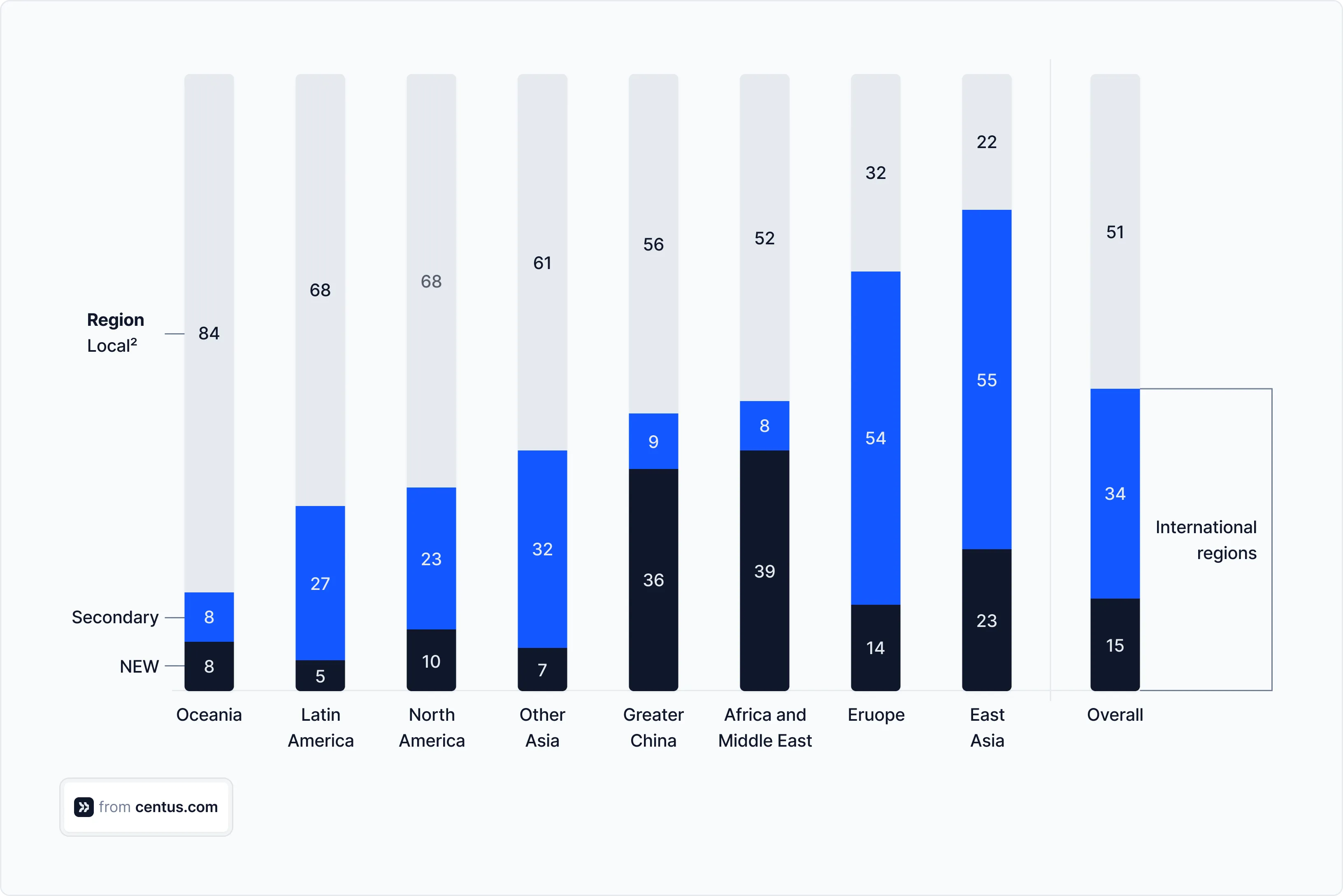
As you can see, half of all corporate growth comes from foreign markets. Half of all growth!
Did we find a good reason for global ambitions? If yes, let’s dive in and explore the most popular global expansion strategies.
What is global expansion?
Global expansion happens when a business expands its operations internationally, outside the local market. The expansion can involve various business activities, from international trade and importing to manufacturing or employing abroad.
To ensure we’re on the same page, let’s clarify what global expansion is not:
- Global expansion IS NOT the expansion of operations within the same country
- Global expansion IS NOT restricted to just selling goods or services abroad
While the first point may seem obvious, the second is often missed. As a result, global business expansion usually becomes a synonym for global trade, which it is not.
How can you expand your business beyond selling abroad?
You can adopt one of these five archetypes of global companies formulated by McKinsey 👇
| Archetype | Examples |
|---|---|
| Resource Seekers | Mining companies (e.g., Rio Tinto, De Beers, ExxonMobil) |
| Researchers | Pfizer, Google, IBM R&D |
| Global Offerers | Louis Vuitton, Apple, Coca-Cola |
| Networkers | FedEx, Emirates Airlines, DHL |
| Customizers | Unilever, Procter & Gamble, Nestlé |
Purpose of global expansion
Companies adopt different methods to go global, but the primary reasons for global expansion typically fall into these categories:
- Creating more demand for products/services in new markets
- Reducing costs by operating in new locales
While revenue increase and cost reduction are the main reasons why companies go global, there are many additional benefits and, unfortunately, risks that can hinder an organization's ability to grow internationally.
The benefits and challenges of global business expansion
Why do companies go global?
The answer lies in four key areas: strategy, cost, risk, and people. Interestingly, each of these can either be a benefit or a challenge on the journey to global business growth.
Strategy: Unlocking opportunities vs the need for flexibility
-
👍 Geographic expansion offers many strategic benefits. Companies can extend their reach, build a better network, partner with local allies, expand their customer base, and boost brand recognition.
-
👎 Going global requires companies to be agile and quickly adapt to country-specific needs. Meanwhile, nearly 70% of SMBs feel uncertain about their ability to keep up with ever-shifting consumer preferences and technology changes.
Cost: Economies of scale vs management complexity
-
👍 By expanding globally, companies can achieve economies of scale and build a new scalable, cost-effective global infrastructure. Bulk purchasing, access to lower-cost labor, new resources, and technologies help businesses cut costs and boost efficiency across the board.
-
👎 Building a global infrastructure isn’t cheap. As operations expand, so does the complexity of logistics and management, increasing coordination costs. Additionally, noncompliance in new markets can cause penalties, adding to the financial burden.
People: New talent pools vs cultural barriers
-
👍 Multicultural teams can fuel innovations by bringing diverse perspectives, broader skillset, and greater creativity to the table.
-
👎 Winning the war for talent in local markets can be challenging, especially now that the world is shifting to the remote work model. Talented candidates can choose from a wide range of international employers, intensifying competition. Managing teams spread across different time zones and cultures isn’t easy either.
Note Cultural differences can impact business strategies, especially if a company falls under the Customizer archetype. For example, Apple had to modify its Face ID technology to enable partial face recognition in Japan, where many people wear face masks.
Risks: Higher resilience vs unfamiliar risks
-
👍 Global companies don’t rely on only one local market. They diversify their portfolio and revenue streams, which help them become more resilient to economic downturns, currency volatility, and geopolitical uncertainties.
-
👎 Greater geographic reach forces companies to navigate unfamiliar compliance, political, and legal landscapes in new markets. Risk management becomes more complex and sometimes unpredictable, resulting in slower responses to emerging issues.
Types of global expansion strategies
Now that you know the benefits of global expansion, you may wonder how to expand your business globally. For starters, develop a global expansion strategy.
There are four key global expansion strategies:
The strategies differ by the following criteria:
- Product standardization
- Local responsiveness (adaptation to local markets)
- Level of centralization
- Cost-effectiveness
- Brand consistency
In the following sections, I’ll cover these strategies in great detail. I’ll also visualize their alignment with each criterion using a score from 1 to 5.
1. Global strategy
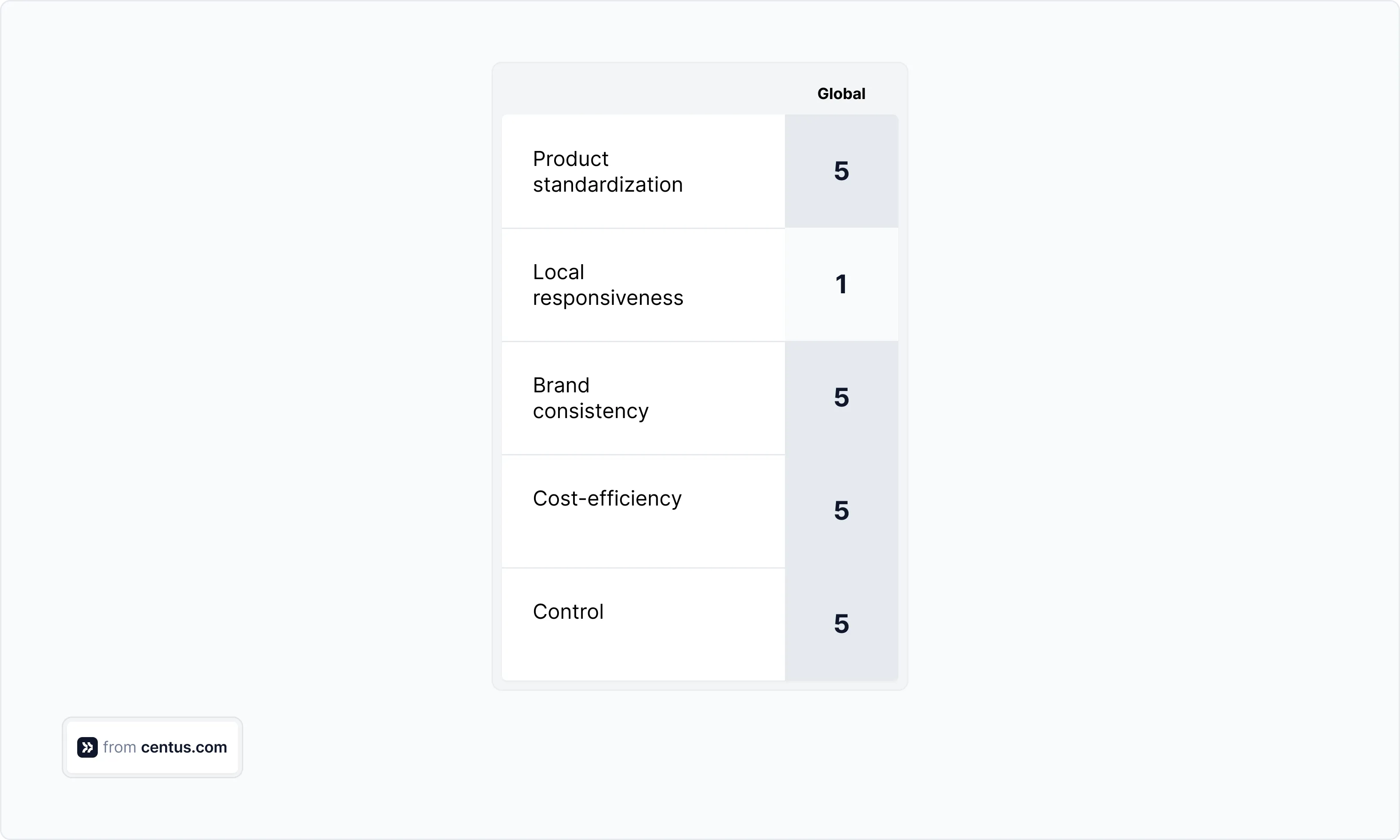
The global strategy allows companies to maximize economies of scale thanks to a high standardization of their operations and portfolio with no or minor local differences. The decision-making power is concentrated in domestic headquarters, making local subsidiaries highly dependent on the strategy and management of the center.
Uniformity in offerings and consistency in supply and global business operations make this strategy highly cost-effective and scalable. However, global strategy suits markets with similar needs and requires a strong brand identity to make customers from different countries want to purchase exactly the same product.
Example: Microsoft and Apple rely on strong global brands, allowing them to standardize their operations abroad. Although localized, Apple’s and Microsoft’s offerings are largely the same in different countries.
2. Transnational strategy

The transnational strategy is all about balance. While headquarters sets the core strategy for global expansion, local subsidiaries are allowed to adapt it to the needs and preferences of the specific market.
Under the transnational strategy, the product line is standardized but leaves room for “local flavor.” Companies choosing this strategy are usually industry leaders with strong brand consistency over their offerings.
By combining standardization with local relevance, companies benefit from cultural adaptation without sacrificing global efficiency. However, although moderate market adjustments allow companies to minimize investments, this level of balance can be hard to manage over time.
Example: Such giants as Spotify and Amazon offer a similar experience of their apps worldwide, with a few local adaptations, including language, payment methods, and product selection algorithms.
3. International strategy (also known as exporting strategy)
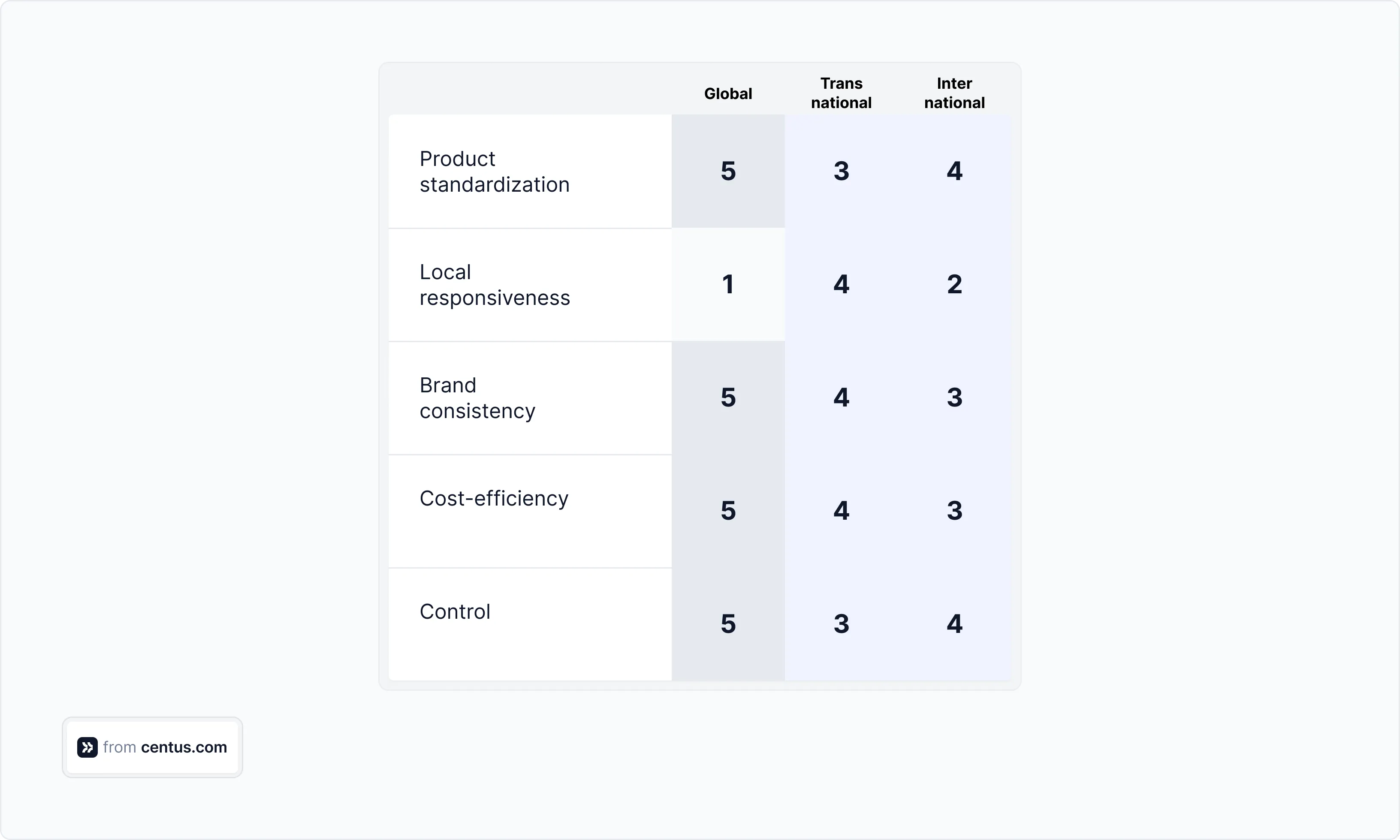
The international strategy works in foreign markets where the home-country approach suffices, and customers accept the company’s offerings as they are. The product is largely standardized, requiring minimal cultural adaptations, such as translation, which allows companies to reduce entry investments.
Like the global strategy, the international strategy relies on centralized management and control. This approach streamlines global market expansion and reduces the risk of brand dilution. However, to succeed, a company needs to have a strong recognizable brand or work in a niche industry.
Example: Grammarly uses an international strategy targeting English-speaking users with the same app interface and functionality across markets. However, the app supports different types of English (like American and British) to meet regional grammar differences.
4. Multi-domestic strategy
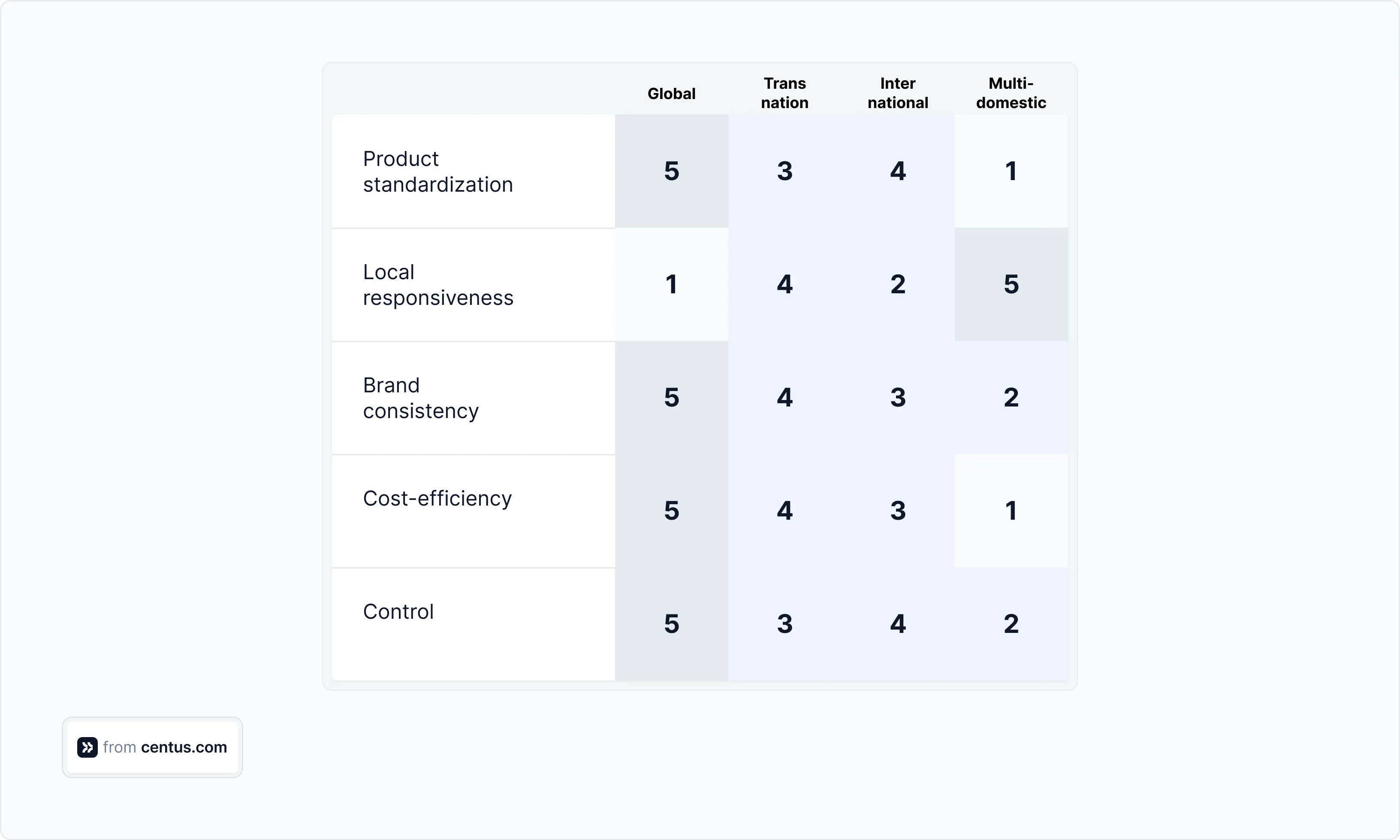
The multi-domestic strategy requires companies to maintain the highest level of product adaptation to local differences. This also means higher implementation costs and decentralization of the company’s operations. Local subsidiaries receive more autonomy and are allowed to make decisions independently from the headquarters, which can result in management complexity.
Product line usually significantly differs across markets to target specific local tastes and preferences. By focusing on market gaps and local trends, companies can better connect with customers and have higher satisfaction rates.
Example: Uber Eats customizes its offerings to fit local food cultures. In South Korea, where customers emphasize food presentation, Uber Eats had to work with restaurants to arrange dishes as they would look in a restaurant, not just tossed into containers.
As with everything else, there is no one-size-fits-all approach. Companies typically choose the above-mentioned strategies to expand business globally but rarely stick to only one of them.
A case in point is Netflix. They started with an international strategy with minimal local adaptation, but as the company grew bigger, they quickly discovered the benefits of local responsiveness, especially for Asian markets. In South Korea, for example, Netflix invested in K-dramas, and in India, they launched a mobile-only plan to target price-sensitive audiences.
How to build a global expansion strategy
Now that you know the types of global expansion strategies, let’s see how to build one for your business.
Step 1: Find your competitive advantage
One of McKinsey’s key growth rules, derived from a 15-year study of the 5,000 largest public companies, is simple 👇
💬 “Go global if you can beat local. Expand internationally if you have a transferable advantage.”
Before you even start building a global growth strategy, you need to clearly understand your competitive advantage and assess if it can be effectively transferred to other markets. Otherwise, you might find yourself struggling against local businesses on their own turf—and that’s hardly a winning move.
So, how do you define your competitive advantage in a new market?
- Start by getting to know what potential customers actually need. Instead of assuming the new market will be just like your current one, take a fresh approach—forget what you think you know and dive into understanding their unique demands and opportunities.
- Take a close look at the local players. What value are they bringing to customers?
- Finally, map out what you bring to the table and how it benefits your new audience.
In the best-case scenario, you’ll discover a need that’s not yet covered by competitors—this is where your advantage lies.
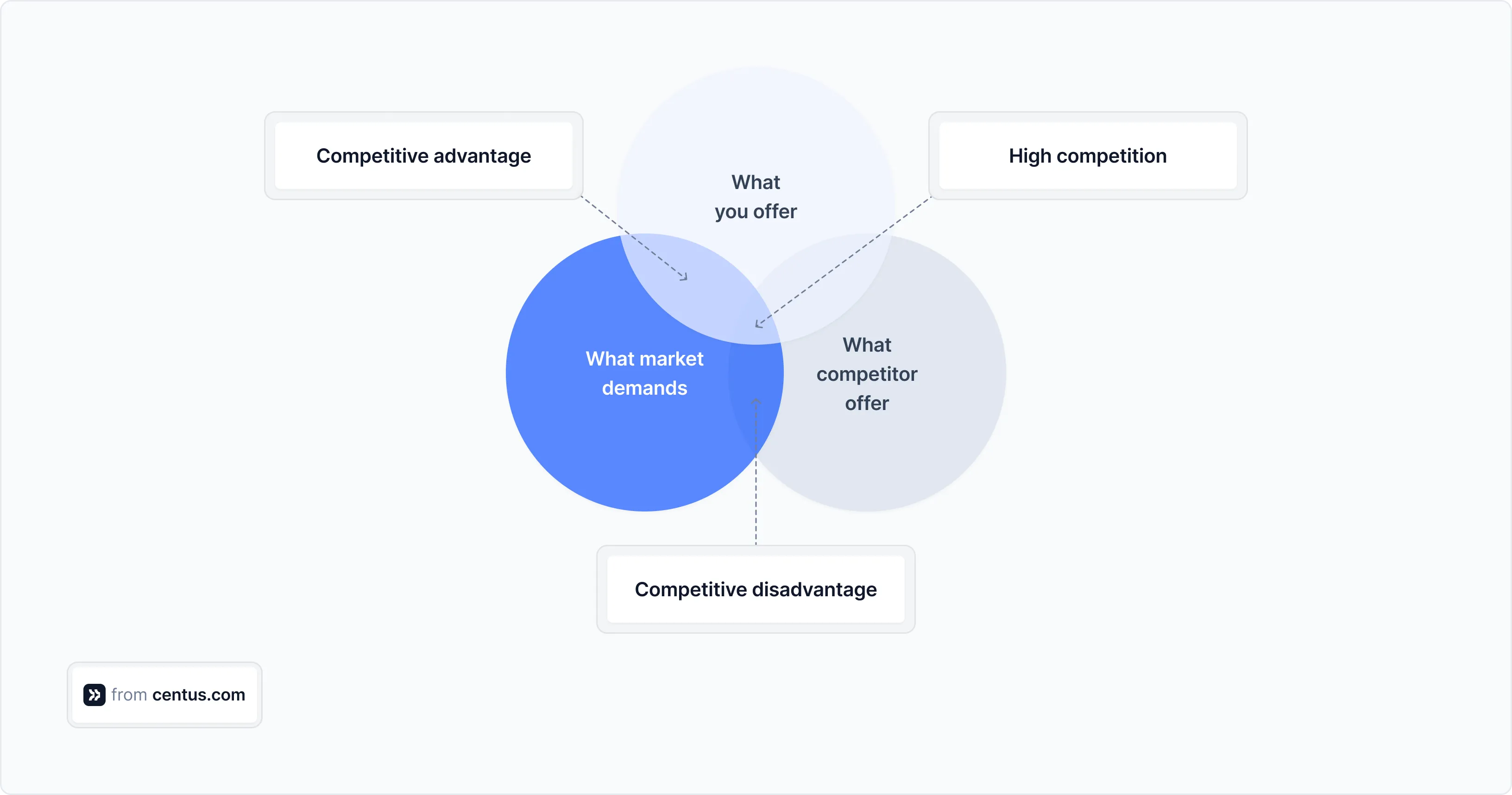
Step 2: Conduct market research and risk assessment
Meticulous research helps you mitigate risks, calculate the return on investment, and make informed decisions during the next stages of strategy building. I recommend starting with the PESTEL framework for the big picture and then using a SWOT analysis to examine internal factors within your control.
First, focus on these key macro factors:
- P-political. Consider governmental stability, political climate, and the risk of conflicts.
- E-economical. Evaluate consumer spending power, taxation policies, interest rates, and inflation—particularly in your specific industry.
- S-social. Analyze demographics, lifestyle trends, religious and social beliefs—all that affect buying patterns.
- T-technological. Assess technology demands and innovation levels in your sector. If hiring a local team, also consider attitudes toward hybrid and remote work.
- E-environmental. Understand the environmental issues and local views on sustainability. For example, you may discover stricter requirements around energy efficiency, carbon footprint, waste, and plastic usage.
- L-legal. Each market has its own rules, and overlooking them can lead to costly penalties. For example, in 2019, Google was fined €50 million for failing to meet EU GDPR. Ouch!
Now that you’ve outlined the new market’s threats and opportunities with PESTEL, shift to a SWOT analysis to evaluate your internal strengths and weaknesses:

Step 3: Manage global business operations and teams
Not every business is easily scalable, and not everyone is ready for a decentralized management model. Deciding how to structure operations and manage teams will depend on your global expansion strategy.
If you’re going for a global or transnational approach, you’ll need to lower your costs (and prices) to stay competitive in the market. This means higher global integration, standardized offerings and processes, global supply chains, centralized operations and decision-making.
International and multi-domestic strategies, on the other hand, don’t pressure you to reduce costs, giving you more opportunities to build a flexible and decentralized business.
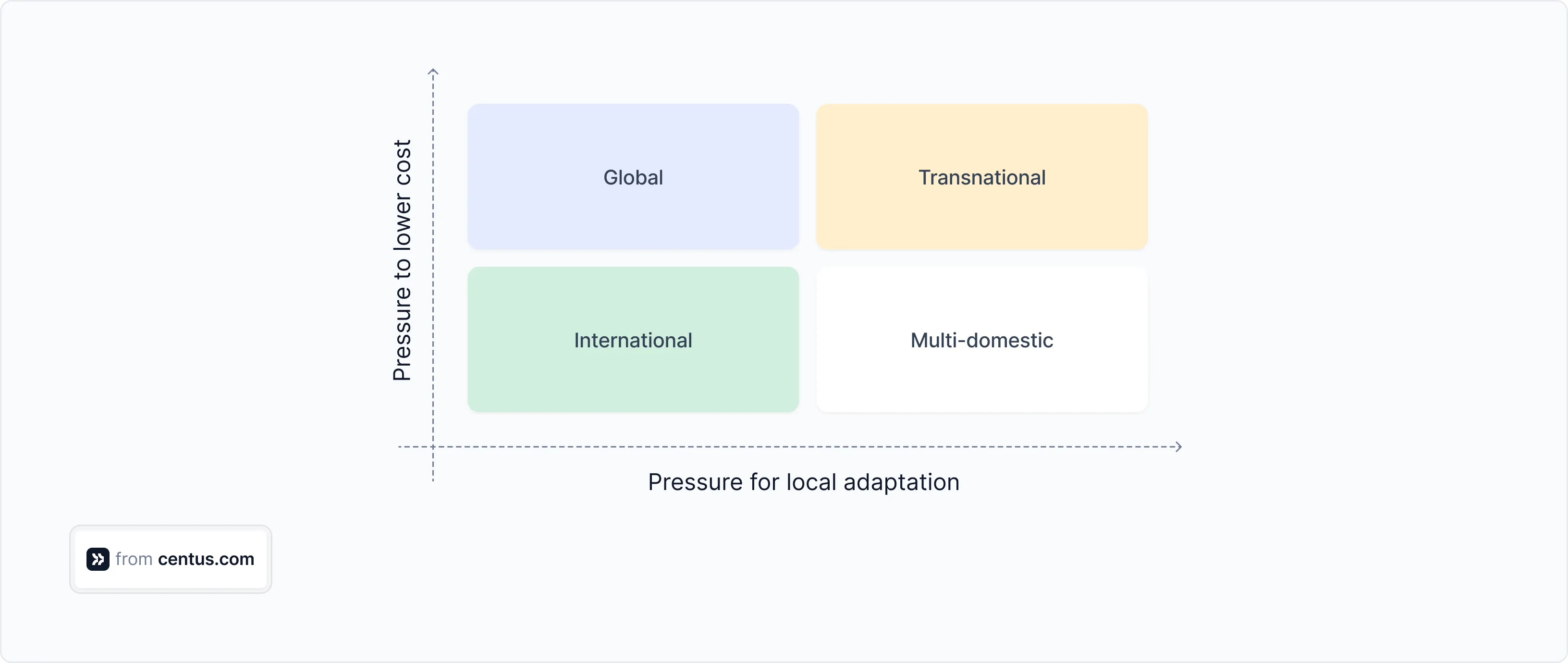
Keep in mind: your team management approach will depend a lot on your strategy, too. The more your product needs to be tailored to local needs, the more closely you’ll work with cross-cultural teams.
| Strategy | Challenges | Solutions |
|---|---|---|
| Transnational | The most challenging as it requires balancing global standards with local differences. | Invest in cultural training, open communication and consistency across regions. |
| Multi-domestic | Emphasizes cultural flexibility but may lack consistent practices across regions. | Establish guidance to maintain consistency and encourage knowledge sharing. |
| Global | While all teams are aligned with a standardized workflow, there is a risk of overlooking local needs. | Hold regular feedback sessions with local teams and promote cross-cultural awareness. |
| International | Team management is simple as it’s mostly centralized, with local teams mainly for regional support. | Invest in localization and cultural awareness training to minimize misunderstandings. |
Step 4: Prepare the market entry (and exit) strategy
Don’t confuse a global expansion strategy with a market entry strategy. The latter is a short-term plan for a specific foreign market and focuses mainly on entry mode, partnerships, and investments.
📘 Relevant reading: 4 Examples of market entry strategies
You can export your product, partner with a local ally, grant local companies the rights to sell and manufacture your products or invest in a local startup.
So, how do you choose what works best for your business?
Here are four factors to take into account:
- 📊 The results of PESTEL analysis to understand market potential and risks.
- 💰 Available financial, human, and other resources.
- 🎯 Strategic goals: the level of control and brand presence you want.
- 💪 Your risk tolerance.
Now, let’s see how these factors can steer you toward the right entry strategy:
-
Exporting is a low-risk approach suitable for uncertain markets when you have limited resources and want low commitment. On the flip side, exporting often comes with reduced brand presence and limited control over local operations—something to keep in mind if brand visibility is a priority.
-
Partnership can be a middle-ground option, giving you moderate control while minimizing risks in markets where you need local expertise (especially when products or services need a local touch). But choose partners carefully—misalignment, misunderstandings, or even brand dilution can happen if you’re not on the same page.
-
Licensing minimizes upfront investments and entry risks. However, there’s a trade-off: this strategy can put you at risk of losing control over the quality of your local offerings. You must also choose markets with strong intellectual property protection laws to protect your ideas from copying or misusing.
-
Investment is NOT for markets where you feel uncertain. Choose this strategy when you are ready for a long-term commitment, high capital and operational risks and want complete control over your brand and market presence.
Overall, if you’re just dipping your toes into global expansion and need low-commitment options, exporting or licensing may be your best choice.
Note: Don’t forget to develop an exit strategy. Set goals and timelines and be ready to use your backup plan if market or business conditions change unexpectedly.
Step 5: Perform cultural adaptation and localization
The level of cultural adaptation depends on the market, brand recognition, product type, competition, and other factors.
High local flexibility offers additional competitive advantage but requires local expertise and often a local team, which is hard to manage and maintain. Conversely, lower adaptivity is more cost-effective but requires a company to have a strong brand or unique offerings.
Regardless of what you choose, localization is essential. Even companies that implement strategies with no or minimal cultural adaptation choose to localize websites, product interfaces, and marketing materials to connect with new audiences.
Parting thoughts
Before jumping into global expansion, remember it’s all about balance—knowing your strengths, preparing for challenges, and staying flexible as you grow. Localization is a big part of that balance and is the essential first step in growing globally.
Ready to make your move? Try Centus now!
Want to prepare better?
Learn how to develop a localization strategy tailored to your business.
Get the week's best content!
By subscribing, you are agreeing to have your personal information managed in accordance with the terms of Centus Privacy Policy ->
Keep learning

19 min. read
Marketing Localization: The Only Guide Worth Your Time
15 min. read
Build a Global Content Strategy in 5 Steps
7 min. read
What is Global Localization: Principles & Strategy
6 min. read
Internationalization and Globalization: What’s the Difference Between?

11 min. read